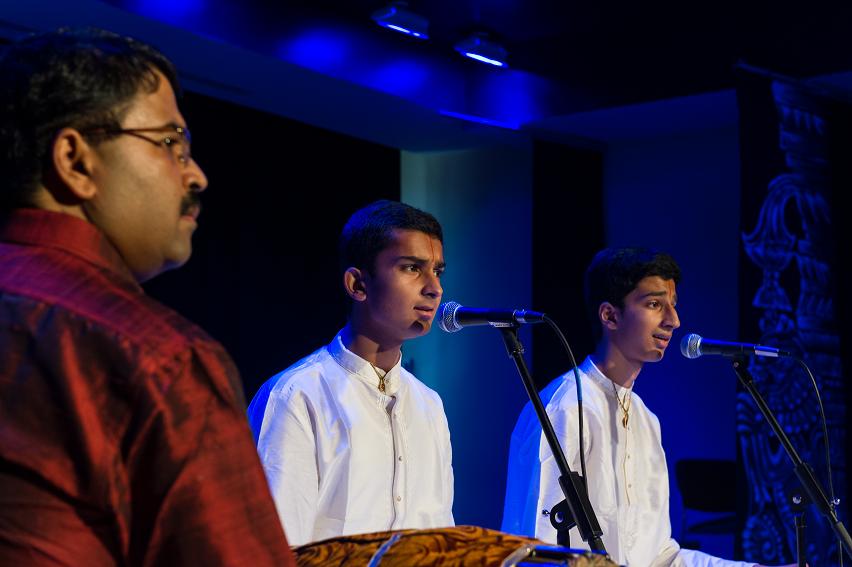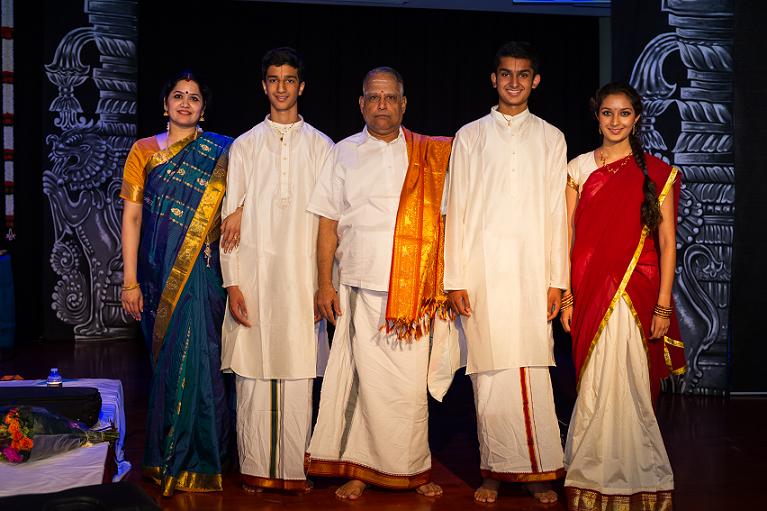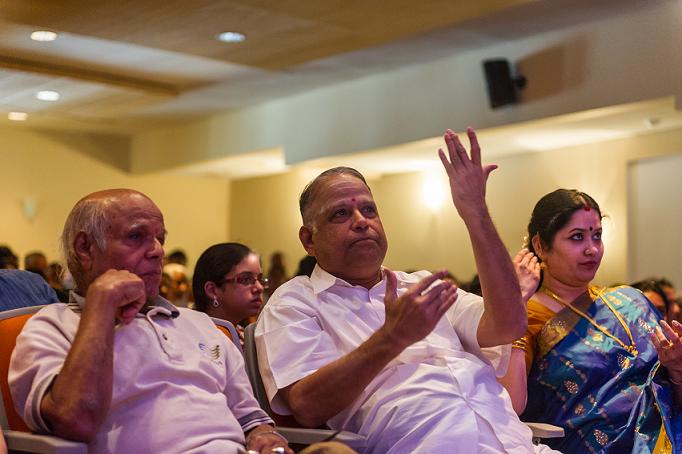Contribute
| Vocal Arangetram: Aneesh Anand And Giridhar Anand |
R. Govind
09/11/2013
In his book, “The Lessons of History,†Will Durant, a noted 20th century historian wrote that “…man picks up his tools and his arts, and moves on; taking his memories with him…civilization migrates with him, and builds somewhere another home.†Bharatiya samskriti or the cultural heritage of India is a yugayatri – traveler across epochs and space. For over a century, the best of Bharatiya Samskriti, representing philosophy, religion, yoga, music and dance, have been steadily diffusing into the United States, largely through visitors from India. Times are changing, however. Now, Indian-American citizens, i.e., the children of immigrants from the 70’s, are not only excelling academically, but also leading a movement toward preserving and propagating the best of our cultural heritage in the US.
A shining example of this movement was showcased by brothers, Mr. Aneesh Anand and Giridhar Anand (also, previously their sister, Suma Anand: http://www.lokvani.com/lokvani/article.php?article_id=9139), disciples of Smt. Aparna Balaji of Abhyaas School of Music, at their Arangetram on August 11, 2013 at Chinmaya Mission, Andover, MA. The occasion was graced by Sri O.S. Thiagarajan, a leading exponent of Carnatic Music and a winner of the prestigious Central Sangeetha Natak Academy award. Musical instrumental support was provided by an ensemble of senior artists, Drs. Mr. KVS Vinay on the violin, Ravi Balasubramanian on the Ghatam and Sri Mahalingam Santhanakrishnan on the Mridangam. The flawless rendering of Carnatic music with a wide range and hue for over three hours by the brothers Giri and Aneesh reminded me of the performance by the teen-age (now famous) Rudrapatnam Brothers concert in the early 70’s in Bangalore.
Aneesh and Giri opened the concert with a varnam, Nera Nammi, in ragam Kanada set to Atta Talam. Their beautiful and confident rendition of the varnam with the attendant nuances of this ragam and the talam paved the way for the rest of the concert. They maintained the same composure, vibrancy and quality.
The next brisk piece was Chidambara Bharathi’s Pahi Pahi, an invocation in praise of Lord Vinayaka. This composition, set in ragam Hamsadwani, a very auspicious ragam at the start of a concert, was rendered with dynamic kalpanaswarams and ushered in a joyous mood for the entire concert to follow!
The piece Baagayanayya in Ragam Chandrajyothi flowed next – a rare piece by Saint Thyagaraja on Lord Krishna, and an incredibly moving song. The boys’ deep and complimentary quality and texture of voice gave the range of expression of bhaki and bhava intended by the Sage.
The next piece was the concert’s first elaborate item, rendered in Sriranjini, a famous composition of Saint Thyagaraja on Lord Rama. Saint Tyagaraja’s boundless devotion to Sri Rama came out so well in their rendition with the neraval and kalpanaswarams embellishing it further.
The interlude between the sub-main and the main piece of the evening was in the moving ragam of Vasantha Bhairavi, Prasanna Venkateshwaram, a composition of Sri Muthuswami Deekshitar on Lord Venkateshwara,
This transitioned smoothly into the main piece in the grand raga, Kalyani, Sundari Nee Divya, by Saint Thyagaraja. Every aspect of this main piece, the alapana, the sahithya, and the manodharma components of neraval, kalpanaswaram, koraippu and korvai were elaborate, innovative, crisp, and dramatic. The support from Vinay at all times was sublime. A very special thani avarthanam (percussion solo), mesmerisingly performed by Mali and Ravi, alternating very complex rhythmic patterns on the mridangam and ghatam respectively, formed the latter part of a consistently uplifting main piece. The lively and grand piece, Bhogindra Shayinam was brilliantly portrayed by the brothers next, in the ragam Kunthala Varali, a composition by Swathi Thirunal on Lord Venkateshwara.
Another stellar piece of the entire concert was the Ragam-Thanam-Pallavi (RTP), in Raga Panthuvarali. The somber mood of the ragam was displayed beautifully by Aneesh and Giri, with Giri taking the lead in Ragam and Aneesh taking the lead in Thanam. Between the two of them, with the tempo slowly building up, richly supported by melody, layout and rhythmic patterns, they transported us to a different world! Their effortless delivery of the pallavi, a composition by G.N. Balasubramanian, in praise of Goddess Parvathi, in different kalams and kalpana swarams in different ragams enthralled the audience.
The melodious and devotional Sri Vitaladasa’s “Sada Enna Hrudayadalli†[always dwell in my heart Srihari, … I shall praise the lover of gana by placing (him) in the middle of jnana mantap (temple of knowledge) studed with nine jewels, and worship in mediation …] followed the RTP. The Anand brothers did full justice to the beautiful sahityam in Kannada and the emotive raga Behag. This devotional and meditative kriti was contrasted by the foot-tapping fast composition of Sri Oothukkadu Venkata Subba Iyer, Madava panchakam, in Rag Jog, was energetically and wonderfully rendered by Aneesh and Giri next.
The next piece was a rare composition of Saint Tulasidas on Lord Krishna, in Rag Hemanti. This was preceded by a Shloka on Krishna by Giri. Together the devotional mood that they ushered into the auditorium was felt by all. The next song, Enna Thavam Seydanai, dovetailed perfectly onto this one, with the appeal to Yashoda, Lord Krishna’s mother, in Rag Kapi. Their soulful rendition portrayed the unbound love between the devine mother and son.
The fitting finale to Aneesh and Giri’s performance was a somber and evocative thillana in Raag Revathi, a perfect ragam for the deep and resonant voices of Aneesh and Giri. A composition by Lalgudi Jayaram in praise of Muruga, the brothers did full justice to the raga, the lyrics, and the rhythm.
The chief guest O S Thiagarajan was highly appreciative of Aneesh and Giri’s dedication, stamina, and talent as well as for engaging the audience for over three hours, which is a rarity even in Chennai. He admired their years of single-minded dedication to learn Carnatic vocal music in its finest form from one of the teachers who has direct lineage with Saint Tyagaraja. He encouraged them to continue this artistic pursuit so they can further refine their voice and smooth out all rough edges. Aparna was in all praise of Giri’s innate talent and Aneesh’s effortless rendition, especially in the kalpanaswaras. I, for one, was deeply impressed by their attention to pronunciation of words (swara shuddhate) in at least three languages – Kannada, Tamil and Telugu; despite their American upbringing. It was flawless.
Aneesh, Giri and Suma have also set another standard – they are all pursuing science at MIT. This reminds me of a couplet by D. V. Gundappa (DVG), a great Kannada philosopher-poet. “Tree becomes beautiful with the union of old roots and new shoots…if words of sages mingle with the art of science - it enriches people’s lives.†I experienced the profound meaning of DVG’s poem at the “Aneesh-Giri†concert. I hope these children will continue to explore and connect the roots of the timeless and limitless cultural dimensions of India with science at MIT and beyond, and further spread the best of our grand cultural heritage in our adopted land. At their Arangetram, Aneesh and Giri demonstrated that they supremely qualified and equipped to fulfill our aspirations.
You may also access this article through our web-site http://www.lokvani.com/


